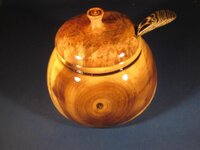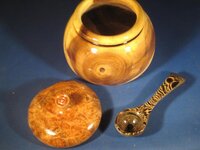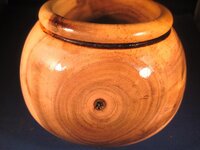OldWrangler
Member
I guess this should be tacked on the end of the Mulberry Pot but that thread has gotten worn out. And besides, I really like how all the things I did came together and made this cute little pot.
The pot is a log of Contorted Mulberry (from my backyard). After turning and sanding to 400 grit, the pot was fumed overnight in ammonia to darken the center of the log and make the figure pop.
The lid is a nice tight fit and turned from a block of Thuya burl. I like how the finial came out....nothing deliberate, it just evolved as it was being turned.
The spoon is hand carved from Wenge and then soaked for an hour in clorox to whiten and accent the grain.
I think Pooh would approve!!!!!!!!
The pot is a log of Contorted Mulberry (from my backyard). After turning and sanding to 400 grit, the pot was fumed overnight in ammonia to darken the center of the log and make the figure pop.
The lid is a nice tight fit and turned from a block of Thuya burl. I like how the finial came out....nothing deliberate, it just evolved as it was being turned.
The spoon is hand carved from Wenge and then soaked for an hour in clorox to whiten and accent the grain.
I think Pooh would approve!!!!!!!!




![IMG_2223[1].jpg](/data/attachments/4/4857-881db9d0e322fee87830eb414ec2d4f0.jpg)
![IMG_2224[1].jpg](/data/attachments/4/4877-7da5c5d3349d2d2e48f474076425724e.jpg)